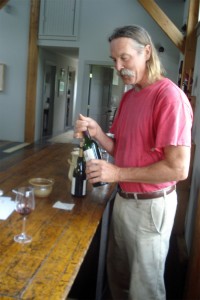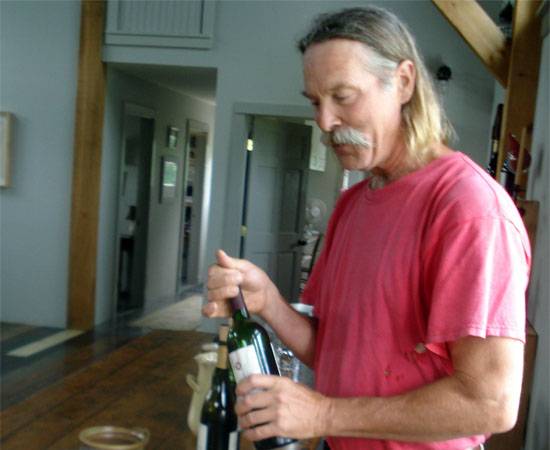
You can only be a cult winery for so long. Eventually, the secret-handshake nature of your clients’ fandom becomes widespread, and then you’re just a regional mainstay. That was true at Heart & Hands, it was true at Damiani, and eventually it will be true at Bloomer Creek Vineyard.
Not yet. There is still a sense of excitement among those who have visited Bloomer Creek in the past two years. There is a kind of illicit knowledge, an ahead-of-the-curve edge. The critical drumbeat is growing, but owners Kim Engle and Debra Birmingham have not seen an explosion in the tasting room.
“Not exactly,” Kim says with a wide grin on a late Saturday afternoon. “We’d like to say that’s true. Certainly there are more people coming in who have read the stories, and it’s frankly inspiring to taste with people who get it.”
Give Engle credit for refusing to play it safe after a rush of attention following his extraordinary wines from the 2009 vintage. The 2009 Bloomer Creek Rieslings are among the finest riesling lineups any winery has yet produced in this region, and their success turned writers on to the excellent wines that began flowing from Bloomer Creek in the 2007 vintage. That’s when Engle began to gain some comfort with discomfort, a kind of willingness to embrace risk and abandon certainty.
His 2010 rieslings are not as exotic as the 2009, and there are reasons for that, but they are built with the same kind of patience and risk: long, cold fermentations that stretch the better part of a year instead of the customary several weeks. Engle is not a fan of temperature control, and so his wines kind of meander at their own pace toward conclusion. It’s an approach similar to that employed across Seneca Lake at Hermann J. Wiemer, but almost nowhere else in the region.
“As winemakers we tend to be so cautious about not having a flaw that we place what’s acceptable in such a narrow category,” he says as he pours the 2010 rieslings. “And that goes for writers, and critics. We drill it into people that a wine must look and smell and taste a certain way. Anything outside that box, and you’ve done something wrong.”
He shakes his head slowly, smiles and adds, “Where’s the complexity in sameness? It’s like we’re afraid of real complexity. We just want the basic demands met, and no more.”
There are critics who would argue that Engle is offering a rationalization for wines that go to the edge — and occasionally over it. His 2009 rieslings are rich, dense, layered, and still braced with the acidity of a cool vintage, but some find the flavor profile too far out there. Engle doesn’t mind. “I am not offended when people say they don’t like those wines. There are dozens of wines from this region that they’ll enjoy, and that’s great.” He concedes that in the past, he’s lost a batch or two of red wine to volatile acidity. “I’m more than willing to learn from that,” Engle says, but it should be noted that the wines Bloomer Creek sends to bottle are not the flawed sort.
Engle says his belief in making wines without cultured yeast has only been fortified in recent vintages, and he asserts that wine should be bifurcated to consider those bottlings made with cultured yeast, and those without. “You can’t compare wines from native yeast versus wines from cultured yeast,” he says. “Ambient yeast leads to a struggle to ferment. Nothing comes easy. That struggle creates complexity in the finished wine that you might not get from cultured yeast.”
It’s an interesting thought, and all the easier to defend because there is no measurable level of complexity. Tasting the Bloomer Creek portfolio, it’s easy to understand why Engle has reached this conclusion. He’s wrong to say that wines from cultured yeast can’t reach the same level of complexity, but perhaps only because he’s being too reductive in pointing solely to yeast strains. Often a winemaker using ambient yeast is also taking the same kind of steps that Bloomer Creek takes to preserve a wine’s sense of place. Gentle handling, long and cold fermentations, ambient yeast — the combination of factors might very well bring more complexity to the finished product.
But why not play it a little safer at this point? That’s what I ask Engle as continue through the lineup. After all, his winery makes no more than 2,000 cases annually. He’s now selling wines in multiple places in Manhattan. There is growing interest. Why risk a wine that some might think is too… different?
“It takes some fortitude to do things a different way, I guess,” he says, “but this is who we are. It would feel foreign to change things now. If people keep coming, that’s great. If they don’t, they don’t.”
The 2010 Bloomer Creek wines, already selling briskly, are strong without a weak spot in the group. Engle’s cabernet francs are developing a kind of thumbprint of earthy raspberry and herbs, while his pinot noirs are surprisingly structured. The 2010 rieslings are not much like the 2009s — that’s too bad for those who were desperate to get the 09s but found them sold out — but why should they be? The growing seasons were vastly different. Engle left a considerable amount of residual sugar in the 09s to balance all that natural acidity, with stunning results. He was confident taking the 2010s much drier, and with strong results, if less exotic. Think creamed peach and key lime, as opposed to the 09s seemingly endless layering of persimmon, baked apple, potpourri, and gorge rock.
And where will the 2011s go? We’ll soon find out. If we’ve learned anything from Engle, we shouldn’t expect anything safe or conventional.

